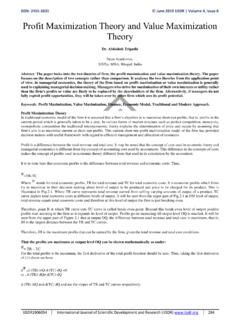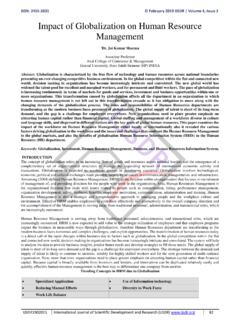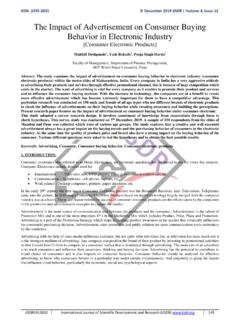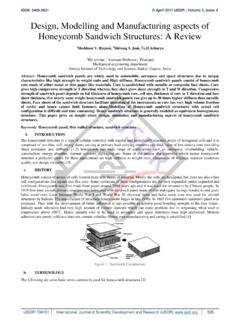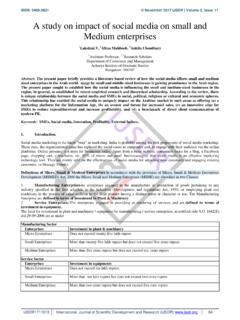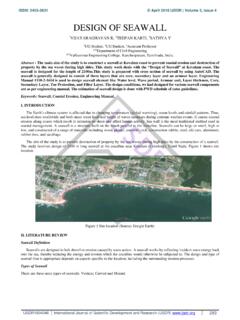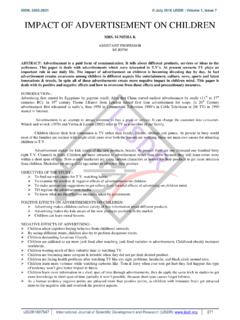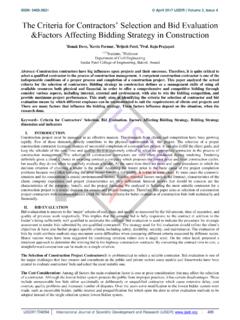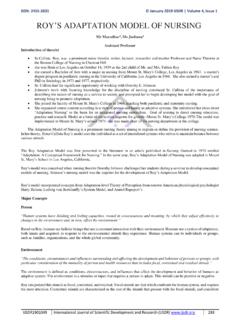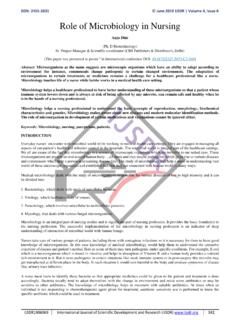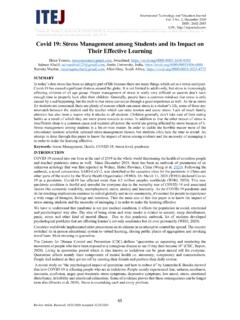Transcription of Misbehavior of School Students in Classrooms - Main …
1 ISSN: 2455-2631 March 2019 IJSDR | Volume 4, Issue 3 IJSDR1903053 International Journal of Scientific Development and Research (IJSDR) 318 Misbehavior of School Students in Classrooms - Main Causes and Effective Strategies to Manage It M Shamnadh1 1 Assistant Professor Department of Mechanical Engineering TKM College of Engineering Kollam, India Anzari A2 2 High School Teacher TKM Higher Secondary School Kollam, India Abstract: Misbehavior within the classroom disrupts Students ' attention and have a negative impact in the teaching learning process. This paper provides the idea about the different types of misbehaviors commonly seen in the schools and the possible factors causing these. Some appropriate strategies for addressing the Students Misbehavior is also been discussed to build good teacher student relationship and thus facilitating the teaching learning process. Keywords: Misbehavior , Teaching Learning Process, Classroom, Teacher Student Relationship.
2 Introduction Misbehavior of Students or negative class participation in the classroom may be disruptive talking, chronic avoidance of work, clowning, interfering with teaching activities, harassing classmates, verbal insults, rudeness to teacher, defiance, and hostility is one of the serious issues especially in secondary Classrooms [1]. Misbehavior often interrupt the smooth functioning of learning process in the classroom. This can unsettle the teachers or other Students in the class. Studies had shown that School Misbehavior not only intensify with time but also lowers academic achievements and increases unruly behavior [2,3]. Misbehavior is closely associated with disciplinary issues that warrants careful action from teachers. Literatures has pointed to the increasing stability of such Misbehavior from early childhood (approximately age 8) to late adolescence and adulthood. Researchers also found that problem behavior in adulthood is invariably preceded by a pattern of such behavior in childhood [4,5].
3 Although the specific behavior may change with development, the relative standing of a child with conduct problems compared to his or her peers remains consistent [4]. Classroom management is done by the teacher to create discipline and motivation and to attract the Students cooperation in the learning process. If the teachers cannot manage their class by various teaching techniques, the teaching process will result in failure[6]. Knowing Students personally, indeed, can help teachers in reducing behavior-related problems in Classrooms . Classroom management is a term that teachers use to guarantee a teaching process free of problems, even with the presence of the Students disruptive behaviors. This term is defined as prevention of the incidence of behaviors that are probably the most difficult aspects of teaching for the teachers [7]. In addition to classroom management, methodology, lesson planning, and Students motivation can be potential control of teachers to inhibit undisciplined atmosphere in their classroom [8].
4 Motivation in Classrooms is more than a way to develop Students interest. Main Causes of Students Misbehavior in the Classroom In order to manage the secondary Students behavioral problems in the classroom, it is important to discuss the causes of Misbehavior . Some researchers argue that student Misbehavior has less to do with the characteristics of Students and more to do with the behavior of teachers [9]. To some extend Students behavior can be provoked by teachers actions, but it is not the whole reason. In the majority of the reasons of student Misbehavior in the classroom, may be followed back to three principle sources: the student, the teachers and the society. 1. The Student Students are bored in learning activities: If Students see School as a place where they are forced to stay despite their lack of interest, it is likely that they will misbehave when they get bored, either to disperse the feelings of boredom, or to add some interest to lesson time.
5 Some Students find it more interesting in winding up the teacher or getting the class to mess around than studying topics which they consider to be dry and dull. Pleasure or lacks of it are important and critical factors that drive Students for more engagement in the activity. On the other hand, when Students do not find pleasure in learning or during the implementation of activities they often withdraw from the educational situation and focus their attention on other things that give them enjoyment [10]. Boredom may influence Students behavior and attitude in the classroom. Studies suggest that bored high School Students are more apt to be disruptive and a boring School experience leads some Students to cut classes and exacerbates Students risk of dropping out of high School [11,12, 13 ,14]. ISSN: 2455-2631 March 2019 IJSDR | Volume 4, Issue 3 IJSDR1903053 International Journal of Scientific Development and Research (IJSDR) 319 Seeking Attention : Attention seeking behavior is anything that a student does to deliberately draw attention to themselves may be from his/her peer group or teachers in the Classrooms .
6 Being the center of attention is a common desire for Students , some more than others. Acting out by making fun of others, swearing, talking out of turn or simply being uncooperative are a few ways of Students misbehaving in the classroom, seeking others attention. These behavior are designed specifically to make other notice them. The need to gain and hold the attention of others appears to be a general human characteristic. Some children try to gain others attention, such as parents or teachers, by being natural and friendly when they grow up in positive environments; on the other hand, some children find they can gain the attention of others by anti-social behavior ( , being impatient or angry) rather than by social behavior. [15] Classroom Environment : A classroom not designed for ideal learning may contribute to a student who refuses to behave. If not approached correctly, a classroom can be set up in a way that does not promote a positive learning environment.
7 There are many things that can affect this environment[16]. There are physical elements such as art on wall, arrangement of furniture s, or other resources. Also, there are other intangible elements such as the rules, the temperature inside the classroom, or the sounds within the room. Each of these can impact a student s focus and achievement in the class. They can also affect a teacher s attitude in the class. Included in each of these elements of the classroom is the emotional environment. The way in which a teacher organizes their class, or how they control it, will yield positive or negative consequences for their Students . If a teacher is unmotivated or negative there will be a direct impact on the Students within the classroom. Lack of interest in the subjects : It is a fact that some Students are simply not at all interested in some of the subjects that they are taught. Perhaps the subjects don t seems those subjects relevant to them and their experience of the world, or perhaps they have a lack of aptitude for certain areas of the curriculum.
8 In the primary School , the teacher might notice a worsening of behavior in literacy lessons, or in art sessions. Because the class teacher sees the child in all the subject areas, it can be slightly easier to find ways of getting around an apparent lack of interest or ability in one specific lesson. In the secondary School , a student who behaves impeccably in PE might be a nightmare for the teachers handling language subjects , and vice versa. The language teacher might come to view this student as really difficult, and be surprised to hear that he or she succeeds in more practical subject areas. Special needs : Special needs can also be an important factor in Misbehavior in Classrooms . If a student is struggling with the work he is assigned or in the learning process, and the teacher does not manage to make it accessible, there is a high chance that the Students may tend to misbehave in the class. In addition to these Misbehavior may arise if the Students are unable to fulfill the task assigned to them by the teachers.
9 Sometimes, the work may be too difficult to do or the teacher explains unclear demands on how the work has to be completed[17]. This situation makes Students learning difficult as they have no idea about what to do and thus resulting in the disruption of learning process in the classroom. 2. The teacher Teachers experiences a good variety of emotions throughout their work that are triggered by multiple factors and their interactions. Teacher emotions generally unfold in interaction with their environment. Teachers interact with totally different individuals in their work ( colleagues, parents), however interactions with their Students appear to be the foremost powerful in terms of evoking positive or negative emotions. Studies has shown that primary and secondary teachers emotions are strongly connected to positive interactions with their Students , evoking responses like joy and satisfaction[18].
10 Alternatively, in terms of negative emotions, studies reveal that negative emotions of teachers ( anger and frustration) were frequently associated with Students Misbehavior or lack of classroom discipline, that increased the risk for burnout over time [19,20]. Classroom discipline issues have conjointly been found to be one in all the most predictors of teacher stress and conjointly impede on teacher enthusiasm. Researchers also found a good correlation between discipline within the classroom and teacher enjoyment, while the correlation was negative for anger and anxiety. identical correlation pattern was observed for student motivation, while there was no vital association between student performance and teacher emotions. Indicating that student engagement was more significant for teachers positive relationship with Students than Students accomplishment level[21]. The types of teacher behavior which student s particularly felt provoked them into Misbehavior are: teachers who are boring, teachers who could not teach well, teachers whose discipline was weak, and teachers who made unfair comparisons [22].
